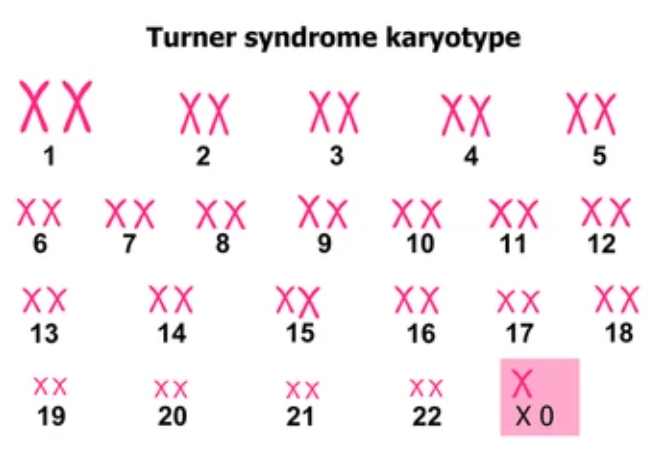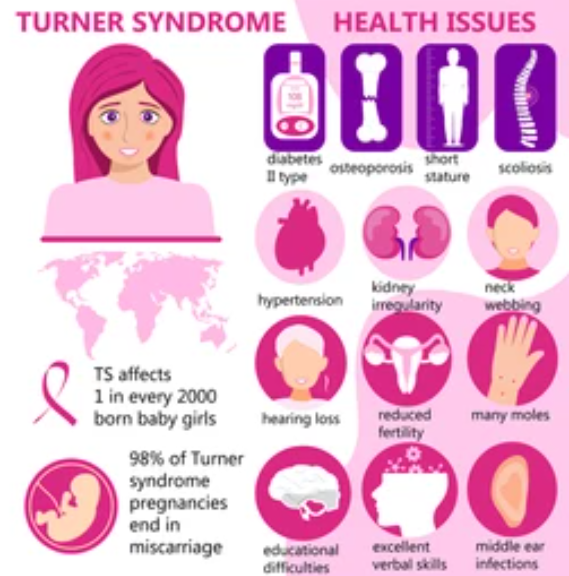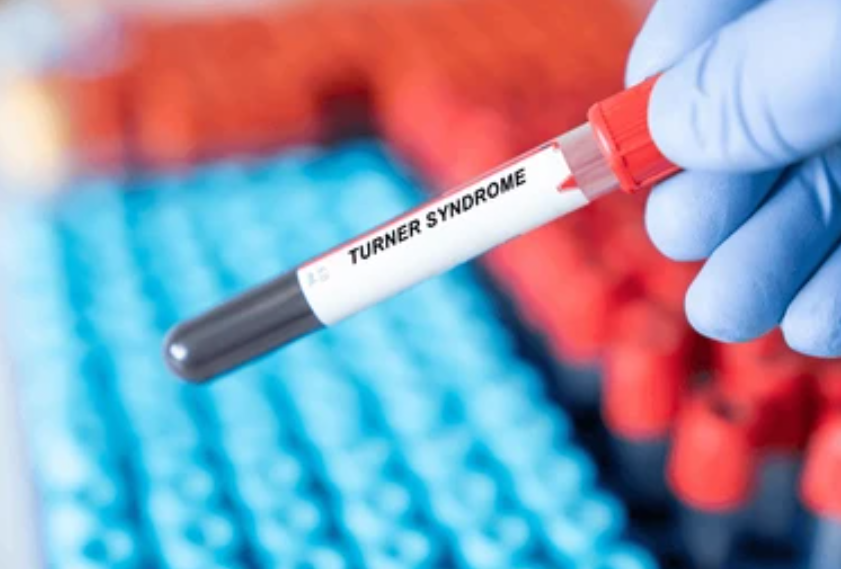INTRODUCTION
Turner syndrome is a genetic disorder affecting females, marked by the absence of one X chromosome in cells, leading to a range of physical and developmental traits. Common features include short stature, distinctive physical traits like webbed neck and low-set ears, and infertility due to underdeveloped ovaries. Hormone imbalances might cause growth and estrogen deficiencies, requiring hormone replacement. Individuals might face heart or kidney issues and potentially experience learning difficulties. Social challenges and emotional aspects can also be present. Early diagnosis through genetic testing allows for tailored interventions involving medical, psychological, and educational support to manage the condition’s multifaceted impacts effectively.
GENETIC AND BIOLOGICAL BASIS

- Monosomy X: The primary genetic abnormality in Turner syndrome is monosomy X, where one of the two X chromosomes is missing in females. This occurs due to errors in chromosome division during conception.
- Chromosomal Variations: While 45,X is the most common chromosomal pattern, other variations like mosaicism (cells with different chromosomal patterns) can also occur, influencing the syndrome’s expression.
- Gene Expression: The absence of an X chromosome disrupts the balance of gene expression and leads to the varied physical and developmental traits associated with Turner syndrome.
- Gonadal Dysgenesis: The underdeveloped ovaries in Turner syndrome result in infertility and reduced estrogen production, leading to delayed or absent puberty.
- Growth Hormone Deficiency: Many individuals with Turner syndrome have insufficient growth hormone production, contributing to short stature.
- Cardiovascular and Renal Effects: The genetic anomalies can impact heart and kidney development, leading to potential cardiac and renal issues.
- Neurodevelopmental Factors: Research suggests possible neurodevelopmental impacts related to the X chromosome’s absence, potentially contributing to learning and social challenges.
CAUSES OF TURNER SYNDROME
Turner syndrome is primarily caused by genetic anomalies that result in the absence or partial absence of one X chromosome in females. The condition occurs due to errors during chromosomal division, leading to various genetic and biological effects:
- Monosomy X: The most common cause is the absence of one X chromosome, resulting in the chromosomal pattern 45,X instead of the usual XX in females.
- Mosaicism: In some cases, individuals may have mosaic Turner syndrome, where some cells have the typical XX pattern while others are 45,X. This can lead to varying degrees of symptoms.
- Structural Abnormalities: Rarely, structural abnormalities in the X chromosome, such as deletions or rearrangements, can also contribute to Turner syndrome.
- Parental Origin: The missing X chromosome can be of maternal or paternal origin, and the specific origin might influence the clinical features and severity of the syndrome.
SYMPTOMS OF TURNER SYNDROME

Turner syndrome can manifest with a range of physical, developmental, and medical symptoms. While the specific symptoms can vary among individuals, common features include:
- Short Stature: A notable trait is short stature, often becoming evident during childhood growth. This is due to the deficiency of growth hormone and other factors.
- Webbed Neck: Some individuals might have a webbed appearance of the neck, caused by extra folds of skin or tissue.
- Low-Set Ears: The ears might be positioned lower than usual on the head.
- Broad Chest and Wide-Spaced Nipples: There might be a wider chest with nipples spaced farther apart.
- Infertility: Most women with Turner syndrome experience infertility due to underdeveloped or absent ovaries.
- Delayed or Absent Puberty: Hormone imbalances can lead to delayed or absent puberty, often requiring hormone replacement therapy.
- Cardiac and Renal Issues: Heart defects and kidney abnormalities can be present, potentially requiring medical intervention.
- Learning Challenges: Some individuals might face difficulties in certain cognitive domains, such as spatial reasoning and mathematics.
- Social and Emotional Challenges: Difficulties in social interactions and self-esteem can be present, requiring supportive interventions.
- Lymphedema: Swelling due to lymphatic system abnormalities can occur in some cases.
- Osteoporosis: Reduced estrogen levels can lead to decreased bone density, increasing the risk of osteoporosis.
- Vision and Hearing Problems: Some individuals might experience visual and hearing impairments.
DIAGNOSIS OF TURNER SYNDROME

Diagnosing Turner syndrome involves a combination of clinical evaluation, medical tests, and genetic analysis. The process aims to identify the characteristic physical traits, assess growth and development, and determine the chromosomal pattern. Key steps in the diagnostic process include:
- Physical Examination: A thorough physical examination is conducted to assess physical features like short stature, neck webbing, and other distinctive traits.
- Medical History: Gathering information about the individual’s medical history and developmental milestones helps in understanding the context of their condition.
- Chromosomal Analysis: A karyotype analysis is performed, which involves examining a sample of cells (often from a blood sample) to determine the chromosomal pattern. In Turner syndrome, the absence of one X chromosome (45,X) or mosaic variations might be observed.
- Hormone Testing: Blood tests can measure hormone levels, including growth hormone and estrogen, to assess hormonal imbalances.
- Imaging Studies: Ultrasound and other imaging techniques may be used to evaluate internal organs, particularly the heart and kidneys.
- Genetic Testing: In cases of mosaic Turner syndrome or certain genetic variations, more advanced genetic testing methods might be employed.
TREATMENTS FOR TURNER SYNDROME
Managing Turner syndrome involves a comprehensive approach that addresses the physical, developmental, and hormonal aspects of the condition. Treatment strategies are tailored to individual needs and may include:
- Hormone Replacement Therapy (HRT): Estrogen replacement therapy is often used to induce puberty and promote the development of secondary sexual characteristics. Growth hormone therapy might also be prescribed to enhance height potential.
- Assisted Reproductive Techniques: For individuals with Turner syndrome who wish to have children, assisted reproductive technologies such as in vitro fertilization (IVF) with donor eggs might be considered.
- Cardiac and Renal Care: Regular monitoring and appropriate medical interventions are essential for managing heart defects and kidney abnormalities, if present.
- Educational Support: Learning difficulties might be addressed through educational interventions that cater to individual learning styles.
- Psychosocial Support: Providing emotional support and counseling can help individuals cope with the social and emotional challenges often associated with Turner syndrome.
- Ongoing Monitoring: Regular check-ups and screenings help monitor growth, hormone levels, bone health, and any potential complications.
- Surgical Interventions: In some cases, surgical procedures might be necessary to correct specific physical anomalies, such as heart defects or lymphedema.
- Bone Health Management: Strategies to prevent osteoporosis, such as calcium and vitamin D supplementation and weight-bearing exercises, are often recommended.
- Lifestyle Modifications: Encouraging a healthy lifestyle, including a balanced diet and regular exercise, can support overall well-being.
- Social Skills Training: Educational and social skills programs can help individuals navigate social interactions and build self-confidence.
CONCLUSION
Turner syndrome is a genetic disorder in females where one X chromosome is missing or partially absent. This leads to varied physical traits and health challenges. Common features include short stature, webbed neck, and infertility. Hormone therapies help manage puberty and growth. Medical interventions address heart, kidney issues, and learning difficulties. Early diagnosis and tailored care enable better quality of life for individuals with Turner syndrome, highlighting the significance of ongoing research and multidisciplinary support.
Discover more from ZOOLOGYTALKS
Subscribe to get the latest posts sent to your email.


